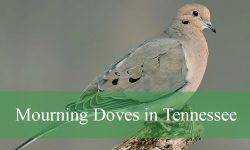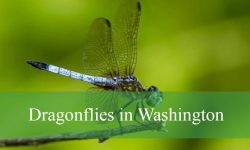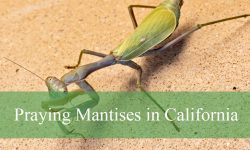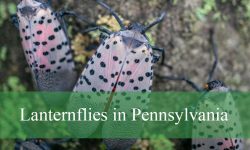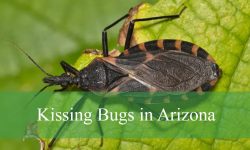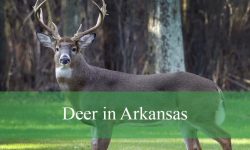Woodpeckers in Delaware offer a fascinating glimpse into the state’s diverse birdlife. From the tiny Downy Woodpecker to the towering Pileated Woodpecker, these birds are famous for their drumming, striking plumage, and distinctive foraging habits.
Delaware is home to both resident and migratory woodpeckers. Some species are commonly seen in backyards, parks, and suburban areas, while others prefer mature forests and open woodlands. Each bird has unique markings, calls, and behaviors that make spotting them a rewarding experience.
This guide highlights 7 woodpecker species in Delaware, providing detailed descriptions, identification tips, habitat preferences, and the best times and places to observe them. Birdwatchers of all levels will find useful insights to enjoy these captivating birds.
Types of Woodpeckers Found in Delaware
Downy Woodpecker (Dryobates pubescens)

The Downy Woodpecker is the smallest woodpecker species found in Delaware, measuring only about 5.5 to 6.7 inches in length with a wingspan of 9.8 to 11.8 inches. Its compact body and short bill make it easily distinguishable from larger woodpeckers. Males display a small red patch on the back of their heads, while females lack this marking. The plumage is predominantly black and white, with a white underside and black-and-white striped back.
Downy Woodpeckers are agile foragers, often seen clinging to tree trunks, branches, and even garden feeders in search of insects. They use their small bills to probe bark for larvae and ants, and occasionally consume seeds or berries. Their drumming is soft and rapid, creating a subtle tapping sound that is less intense than larger woodpeckers.
This species can be identified by its distinctive black-and-white checkered wings, white back, and petite size compared to similar woodpeckers. They are often confused with the Hairy Woodpecker, but the Downy’s shorter bill relative to head size is a key distinguishing feature. Their calls are high-pitched “pik” notes, which are frequent in wooded areas.
Downy Woodpeckers inhabit a wide range of environments across Delaware, including deciduous forests, parks, orchards, and suburban backyards. They are common visitors to backyard bird feeders, especially those offering suet or sunflower seeds. They are non-migratory, often staying in the same territories year-round and adapting well to both natural and urban habitats.
Hairy Woodpecker (Dryobates villosus)
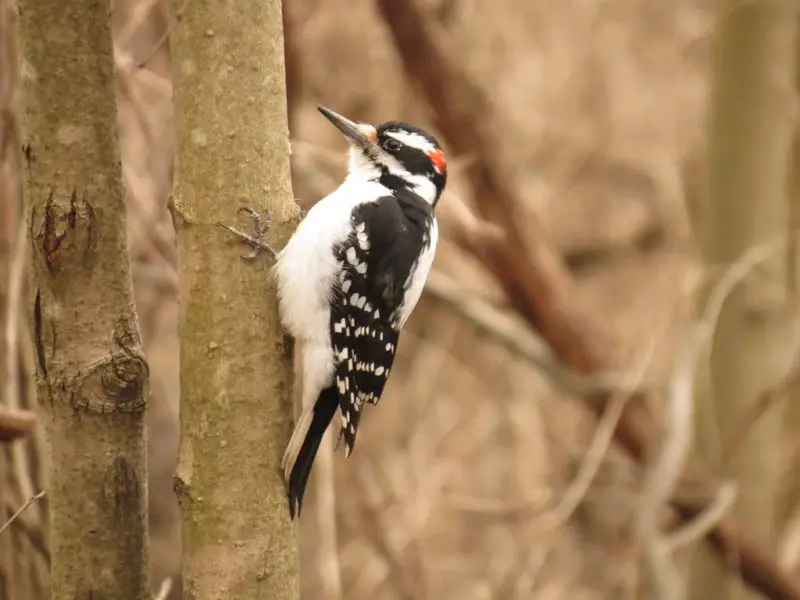
The Hairy Woodpecker is slightly larger than the Downy, measuring 9 to 11 inches in length with a wingspan of 15.8 to 18.9 inches. Its longer, more robust bill is a noticeable feature that sets it apart from its smaller relative. Males feature a small red patch on the back of the head, while females are entirely black and white. The plumage consists of black and white stripes on the back, white underparts, and a predominantly black tail with white outer feathers.
Hairy Woodpeckers are strong and persistent foragers, often seen hammering on tree trunks and branches in mature forests. Their diet mainly consists of insects such as beetle larvae, ants, and caterpillars, but they also consume seeds and berries when insects are scarce. Their drumming is louder and more deliberate than the Downy’s, serving both territorial and mating purposes.
Identification is straightforward due to its size, longer bill, and more robust appearance compared to the Downy. They exhibit a straight, solid back pattern without the soft, delicate look of the Downy. Their vocalizations include sharp “peek” notes, often repeated in quick succession, making them easier to locate by sound.
Hairy Woodpeckers thrive in mature woodlands, mixed forests, and occasionally suburban areas with large trees throughout Delaware. They prefer areas with older trees for nesting cavities and foraging. Though adaptable, they are more commonly found in less disturbed forested regions than in heavily urbanized environments.
Red-bellied Woodpecker (Melanerpes carolinus)
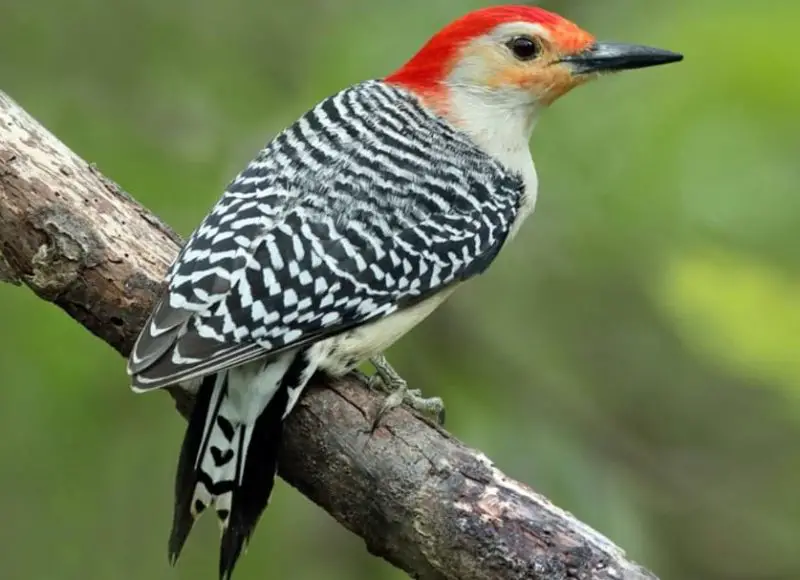
The Red-bellied Woodpecker is a medium-sized bird, ranging from 9 to 10 inches in length with a wingspan of 13 to 16 inches. Despite its name, the red on the belly is faint, while the bright red cap extending from the bill to the nape of males is a prominent feature. The back displays striking black-and-white barring, and the face and underparts are pale. Females have red only on the nape, lacking the extensive crown color.
This species is highly adaptable and frequently seen in both forested areas and residential neighborhoods in Delaware. They forage on tree trunks, branches, and occasionally on the ground for insects, seeds, and nuts. Their drumming is rapid and rolling, and they are vocal, producing a series of loud “churr” or “kwirr” calls throughout the day.
Red-bellied Woodpeckers are easily identified by their bold black-and-white barred back and vibrant red cap, with a slightly pale face and chest. The subtle red on the belly can be difficult to see in the field, making the crown coloration the most reliable feature for identification. They often exhibit confident, active movements along tree trunks.
They inhabit deciduous forests, forest edges, and suburban areas with mature trees. They readily use nest boxes and cavities for breeding, and are common visitors to backyard feeders, particularly for peanuts and suet. Their year-round presence and adaptability make them one of the most familiar woodpecker species in Delaware.
Northern Flicker (Colaptes auratus)
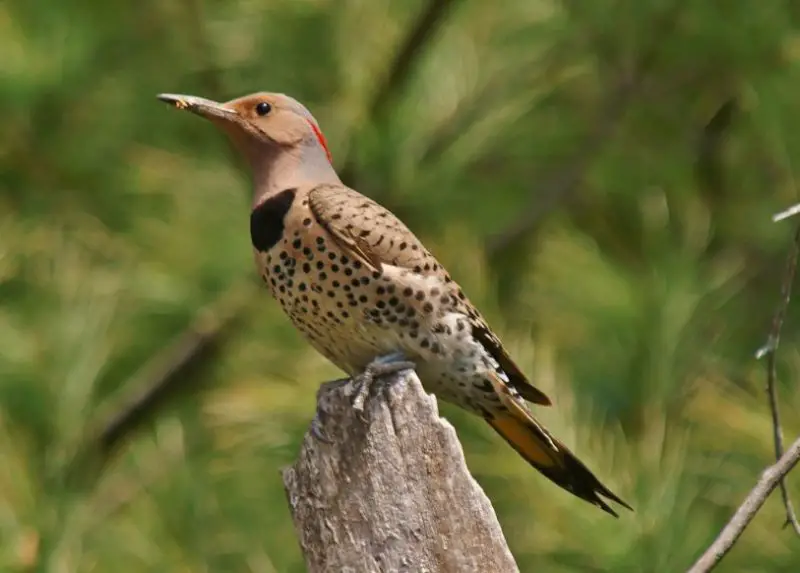
Northern Flickers are among the largest woodpeckers in Delaware, measuring 11 to 14 inches in length with a wingspan of 16.5 to 20.5 inches. They exhibit brown plumage with black barring on the back and spots on the belly, and a distinctive black crescent on the upper chest. Wing coloration varies regionally, showing either bright red or yellow underwings, which is noticeable in flight. Males have a subtle red mustache mark near the bill.
Unlike other woodpeckers, Northern Flickers frequently forage on the ground, feeding on ants, beetles, and other invertebrates, in addition to fruits and seeds. They use a characteristic flicking motion with their bills to dig through soil or leaf litter. Drumming is less common than other woodpeckers, and their call includes a loud, repeated “wik-wik” sound.
Identification is aided by their large size, spotted underparts, barred back, and distinctive flight coloration. Observers can often spot them on lawns or open woodland areas rather than strictly on tree trunks. Their behavior of feeding on the ground is a key feature that separates them from other Delaware woodpecker species.
Northern Flickers inhabit open woodlands, forest edges, parks, and suburban areas throughout Delaware. They prefer habitats with scattered trees and open ground for foraging. While nesting in tree cavities, they are flexible in habitat selection and can thrive near human developments, making them a common and easily observed species.
Yellow-bellied Sapsucker (Sphyrapicus varius)
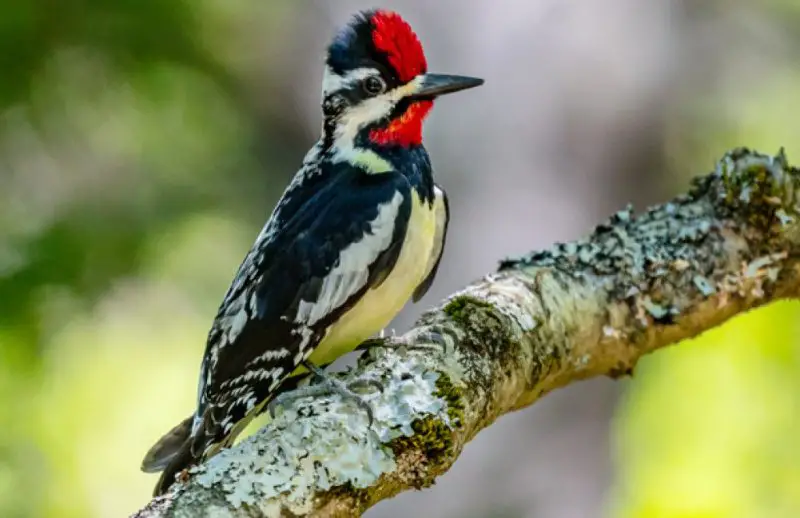
The Yellow-bellied Sapsucker is a medium-sized woodpecker, measuring 7.5 to 9 inches in length with a wingspan of 13 to 16 inches. Males exhibit a red crown and throat, while females show a red crown with a pale throat. Their back is mottled gray and black, and the belly has a subtle yellow tint, which gives the species its name. Their bill is straight and moderately long, ideal for drilling sap wells in trees.
This species is a migratory visitor in Delaware, typically seen during spring and summer months. They feed on tree sap, insects, and fruits, using their specialized tongue to extract sap from small, precisely drilled holes. Their feeding behavior is distinctive, as they often return to the same tree multiple times to collect sap.
Identification is aided by the characteristic red crown, throat pattern, and yellowish belly, combined with the unique rows of sap holes on tree trunks. They are smaller than the Pileated Woodpecker and less boldly patterned than the Red-headed Woodpecker. Observers can recognize their rhythmic tapping and soft “wee-wee-wee” calls.
Yellow-bellied Sapsuckers prefer deciduous forests, orchards, and wooded suburban areas while in Delaware. They often select birch, maple, or fruit trees for sap extraction. Because they are migratory, they are not present year-round but are a reliable sighting in spring and early summer.
Red-headed Woodpecker (Melanerpes erythrocephalus)
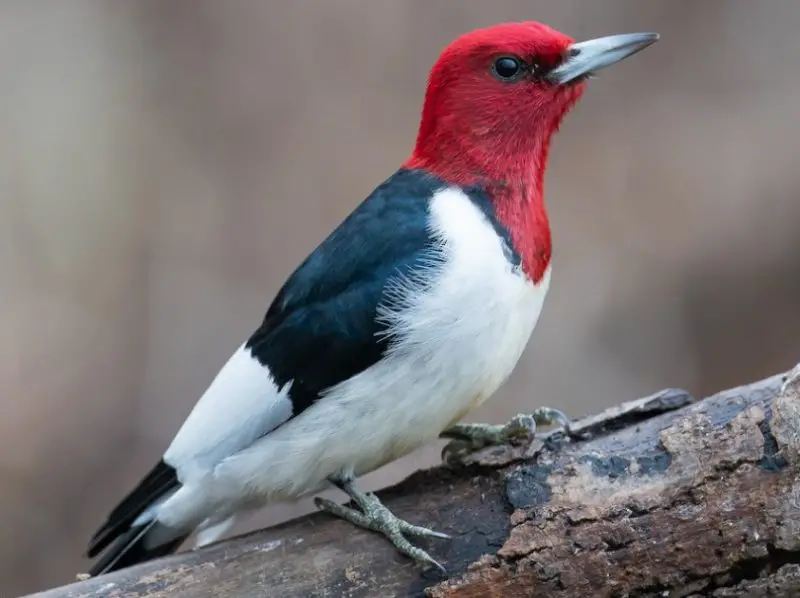
The Red-headed Woodpecker is a medium-sized woodpecker, about 8.3 to 9.8 inches long with a wingspan of 16 to 19 inches. Its most striking feature is the completely red head, which contrasts sharply with the white underparts and black-and-white wings and back. Males and females appear similar, both exhibiting bold, clean coloration with no barring on the head.
This species is rare in Delaware and is typically found in open woodlands, orchards, and scattered tree areas. They feed on insects, nuts, fruits, and occasionally small vertebrates. Red-headed Woodpeckers are known for their habit of caching food, storing it in tree crevices for later consumption, especially in the fall.
Identification is unmistakable due to the solid red head and stark black-and-white body pattern. Their flight shows broad white wing patches that contrast with black flight feathers, making them visible from a distance. They are highly vocal, producing sharp “churr” and “kik-kik” calls.
Red-headed Woodpeckers inhabit open forests, woodland edges, and orchards in Delaware, but sightings are uncommon. They rely on standing dead trees or large limbs for nesting cavities and are more frequently seen in rural or semi-natural areas than in dense urban settings. Conservation of open woodland habitats is important for their presence.
Pileated Woodpecker (Dryocopus pileatus)
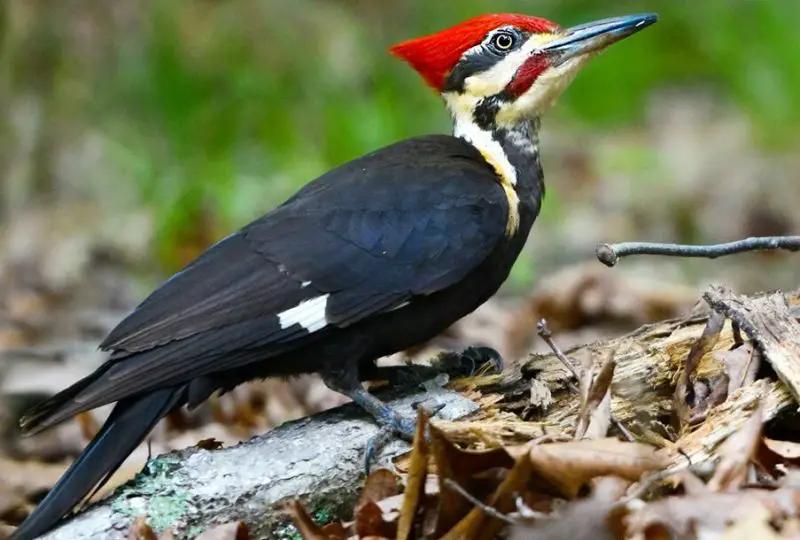
The Pileated Woodpecker is the largest woodpecker in Delaware, measuring 16.5 to 19 inches in length with a wingspan of 26 to 30 inches. Its body is mostly black with bold white stripes along the face and neck, and a prominent red crest on the head. The bill is large and chisel-like, perfect for excavating deep holes in trees to find insects, particularly carpenter ants.
Pileated Woodpeckers are powerful foragers, often tearing apart large tree trunks to access insect nests. They also consume fruits and nuts, but insects remain a primary food source. Their loud, resonant drumming is one of the most noticeable sounds in Delaware forests and serves as both a territorial signal and a communication method during breeding.
Identification is straightforward due to their massive size, red crest, and black-and-white body pattern. Observers can also recognize them by their large rectangular holes in dead or decaying trees. Their flight is strong and direct, with slow, deliberate wingbeats.
They inhabit mature deciduous and mixed forests throughout Delaware, favoring areas with large trees for nesting and feeding. While less common in heavily developed areas, they can sometimes be observed in parklands and large suburban woodlots. Pileated Woodpeckers are non-migratory and typically maintain large home ranges year-round.
Best Time and Places to Observe Woodpeckers in Delaware
Delaware is home to a variety of woodpecker species, some resident year-round and others migratory. For residents like the Downy, Hairy, Red-bellied, and Pileated Woodpeckers, the best time to observe them is during spring and summer, when they are actively foraging, drumming to mark territories, and nesting. Early morning hours, around sunrise to mid-morning, are ideal, as woodpeckers are most active and vocal during these times. Late afternoon can also be productive, especially in quieter suburban areas or woodland edges.
Migratory species such as the Yellow-bellied Sapsucker appear in Delaware mainly in spring and early summer, from March through June. Observers should focus on deciduous forests, orchards, and wooded suburban parks, where these sapsuckers drill sap wells in trees. Peak migration periods, often in late April and May, provide the highest chance of sightings.
Rare or uncommon species like the Red-headed Woodpecker are most frequently seen in open woodlands, forest edges, and orchards during the warmer months, particularly from May to September. They prefer areas with scattered mature trees and open spaces for foraging, so visiting rural farmlands or large parklands increases the likelihood of encountering them. Their bright red heads and striking black-and-white bodies make them easier to spot even at a distance.
For larger woodpeckers like the Pileated Woodpecker, mature forests and large park preserves are the best locations. These birds are non-migratory, so year-round observation is possible, though spring and summer provide the best opportunity to hear their loud drumming and observe nesting behaviors. Sites such as Bombay Hook National Wildlife Refuge, White Clay Creek State Park, and other forested areas in northern and central Delaware are particularly rewarding for spotting Pileated Woodpeckers.
FAQs About Woodpeckers in Delaware
What is the easiest way to identify woodpecker species?
Woodpeckers can be identified by a combination of size, plumage patterns, head markings, and behavior. For example, the Downy Woodpecker is tiny with a short bill, while the Hairy Woodpecker is larger with a longer bill. Red-headed Woodpeckers have a completely red head, and Pileated Woodpeckers are massive with a red crest. Observing drumming patterns and flight wing colors, such as the yellow or red underwings of Northern Flickers, also helps with identification.
When is the best time to observe woodpeckers?
The early morning, around sunrise to mid-morning, is the most active period for woodpeckers. Late afternoon can also be productive, especially in quieter suburban areas. Migratory species like the Yellow-bellied Sapsucker are best seen in spring and early summer, while year-round residents such as the Downy, Hairy, Red-bellied, and Pileated Woodpeckers can be observed throughout the warmer months.
Where in Delaware are woodpeckers most commonly found?
Woodpeckers are frequently found in deciduous forests, parklands, orchards, and suburban backyards with mature trees. Specific hotspots include Bombay Hook National Wildlife Refuge, White Clay Creek State Park, and other forested areas in northern and central Delaware. Open woodlands and forest edges are ideal for spotting rarer species like the Red-headed Woodpecker.
How can I attract woodpeckers to my backyard?
Offering suet, sunflower seeds, peanuts, and fruit can attract many woodpecker species. Installing nest boxes or preserving dead trees for natural cavities provides shelter and breeding sites. Maintaining native trees and shrubs also encourages insects, a natural food source for woodpeckers.
What behaviors should I watch for?
Woodpeckers exhibit unique behaviors such as drumming on tree trunks, probing bark for insects, and caching food in crevices. Northern Flickers often forage on the ground, while Yellow-bellied Sapsuckers create neat rows of sap wells. Observing these behaviors can help confirm species even if visual identification is difficult.

